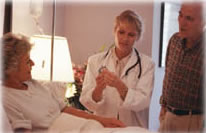


   |
Tick ParalysisBush ticks are mainly found in scrub-covered parts of eastern Australia, from Queensland to northern Tasmania. The adult female feeds off warm-blooded animals such as people, dogs and cats by burrowing into their skin and sucking blood for 3 to 4 days, then falling off and laying her eggs. As she feeds, her saliva-which contains a nerve poison-seeps into the skin and is absorbed. Antitoxin is available and all victims recover after treatment. Signs and symptoms
First aid treatment
WarningYou can become ill even after the tick has been removed and for up to 8 days after leaving 'tick country'. Some people never find the tick at all. If you develop any of the symptoms listed above or become unwell for no apparent reason after being in the bush, see your doctor without delay. |
Online Doctor || Contact Us || Skin Disorders || Diabetes Care || Cellulite Guide || Chemotherapy ||
|
|
(c) Online-family-doctor.com All rights reserved
Disclaimer: Online-family-doctor.com is an information and educational purposes web site only. It is not intended to treat, diagnose, cure, or prevent any disease. Do not rely upon any of the information provided on this site for medical diagnosis or treatment. Please consult your primary health care provider about any personal health concerns. We will not be liable for any complications, or other medical accidents arising from the use of any information on this site.